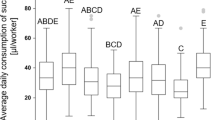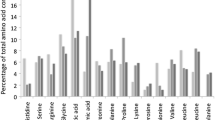Summary
Different-aged honey bees were either kept in a cage together with young sisters for eight days or lived in their colony. Following an injection of14C-phenylalanine (Phe) we measured incorporation of14C-Phe into head protein and total protein, as well as the size of the hypopharyngeal glands. While confined in a cage for four hours, injected bees (from colony or cage) dispensed the14C-labelled protein-rich products of their hypopharyngeal glands to recipients. Eight-day-old colony bees had well developed hypopharyngeal glands, whereas at the age of sixteen days the glands had already decreased in size. Young caged bees had smaller hypopharyngeal glands. Colony bees had higher incorporation rates into total protein and head protein than bees living in a cage. Bees of different age classes, irrespective of caging, fed the same number of recipients; but the amount of14C-labelled protein-rich jelly distributed by caged bees was significantly smaller than that distributed by colony bees. Our results indicate that trophallaxis between young donor workers and newly emerged recipient worker bees is not the key factor for regular development and activity of the hypopharyngeal glands.
Similar content being viewed by others
References
Brouwers, E. V. M., 1982. Measurement of hypopharyngeal gland activity in the honeybee.J. Apic. Res. 21:193–198.
Calderone, N. W. and R. E. Page, 1988. Genotypic variability in age polyethism and task specialization in the honeybee.Apis mellifera (Hymenoptera: Apidae).Behav. Ecol. Sociobiol. 22:17–25.
Crailsheim, K., 1990. Protein synthesis in the honeybee (Apis mellifera L.) and trophallactic distribution of jelly among imagos in laboratory experiments.Zool. Jb. Physiol. 94:303–312.
Crailsheim, K. and E. Stolberg, 1989. Influence of diet, age and colony condition upon intestinal proteolytic activity and size of hypopharyngeal glands in the honeybee (Apis mellifera L.).J. Insect Physiol 35:595–602.
Free, J. B., 1957. The transmission of food between worker honeybees.Brit. J. Anim. Behav. 5:41–47.
Free, J. B., 1961. Hypopharyngeal gland development and division of labour in honeybee (Apis mellifera L.) colonies.Proc. R. ent. Soc. Lond. (A) 36:5–8.
Free, J. B., 1965. The allocation of duties among worker honeybees.Symposium Zool. Soc. London 14:193–201.
Fluri, P., M. Lüscher, H. Wille and L. Gerig, 1982. Changes in weight of the pharyngeal gland and haemolymph titres of juvenile hormone, protein and vitellogenin in worker honey bees.J. Insect Physiol. 28:61–68.
Halberstadt, K., 1970. Ein Beitrag zur Ultrastruktur und zum Funktionszyklus der Pharynxdrüse der Honigbiene (Apis mellifera L.)Cytologie 2:341–358.
Halberstadt, K., 1980. Elektrophoretische Untersuchungen zur Sekretionstätigkeit der Hypopharynxdrüse der Honigbiene (Apis mellifera L.)Ins. Soc. 27:61–77.
Hassanein, M. H., 1952. The effects of infection withNosema apis on the pharyngeal salivary glands of worker honey bee.Proc. R. Entomol. Soc., London27A:22–27.
Hess, G., 1942. Über den Einfluss der Weisellosigkeit und des Fruchtbarkeitsvitamins E auf die Ovarien der Bienenarbeiterinnen.Beih. schweiz. Bienenztg. 1:33.
Huang, Z.-Y., G. W. Otis and P. E. A. Teal, 1989. Nature of brood signal activating the protein synthesis of hypopharyngeal gland in honey bees,Apis mellifera (Apidae: Hymenoptera).Apidol. 20:455–464.
Huang, Z. Y. and G. W. Otis, 1989. Factors determining hypopharyngeal gland activity of worker honey bees (Apis mellifera L.).Ins. Soc. 36:264–276.
Huang, Z.-Y., 1990. A simple in vivo bioassay for estimating the hypopharyngeal gland activity in honeybee (Apis mellifera L., Apidae, Hymenoptera).J. Apic. Res. 29:75–81.
Kaatz, H. H. and T. Takenaka, 1987. Protein synthesis by hypopharyngeal glands of worker honey bees.Chemistry and Biology of Social Insects, Verlag J. Peperny, München, pp. 166–167.
Kaatz, H. H., H. Hildebrandt, F. Dittrich and W. Engels, 1990. Pheromonal effects on the endocrine and reproductive system in worker honey bees.Proc. Conf. Insect. Chem. Ecol., Tábor1990:105–108.
King, G. E., 1933. The larger glands in the worker honeybee: a correlation of activity with age and with physiological functioning. Ph. D. diss., Univ. of Ill., Urbana.
Knecht, D. and H. H. Kaatz, 1990. Patterns of larval food production by hypopharyngeal glands in adult worker honey bees.Apidol. 21:457–468.
Kolmes, S. A., M. L. Winston and L. A. Ferguson, 1989. The division of labor among worker honeybees (Hymenoptera: Apidae). The effects of multiple patrilines.J. Kansas Entomol. Soc. 62:80–95.
Lindauer, M., 1952. Ein Beitrag zur Frage der Arbeitsteilung im Bienenstaat.Z. vergl. Physiol. 34:299–345.
Maurizio, A., 1954. Pollen nutrition and vital processes in the honey bee.Landw. Jb. Schweiz 68:115–182.
Maurizio, A., 1962. Zuckerabbau unter der Einwirkung der invertierenden Fermente in Pharynxdrüsen und Mitteldarm der Honigbiene (Apis mellifica L.).Ann. Abeille 5:215–232.
Michener, C. D., 1969. Comparative social behavior of bees.Ann. Rev. Entomol. 14:299–342.
Michener, C. D., 1974.The Social Behavior of the Bees: a Comparative Study. Belknap Press of Harvard University, Cambridge.
Moritz, B. and K. Crailsheim, 1987. Physiology of protein digestion in the midgut of the honeybee (Apis mellifera L.).J. Insect Physiol. 33:923–931.
Moritz, R. F. A. and M. Hallmen, 1986. Trophallaxis of worker honeybees (Apis Mellifera L.) of different ages.Ins. Soc. 33:26–31.
Park, O. W., 1946. In:The Hive and the Honeybee, (R. E. Grout, Ed.) Hamilton, Ill: Dadant.
Perepelova, L. I., 1928. The nurse bees.Opyt. Pas. 3:551–557.
Robinson, G. E., 1985. Effects of a juvenile hormone analogue on honey bee foraging behavior and alarm pheromone production.J. Insect Physiol. 31:277–282.
Rosça, O., C. Rusu and C. Frasinel, 1972. Effect of protein supplements on the developments and secretory activity of the pharyngeal glands in the honeybees.Lucr. stiint. Inst. agron. II:93–98.
Rösch, G. A., 1925. Untersuchung über die Arbeitsteilung im Bienenstaat I. Die Tätigkeit im normalen Bienenstaate und ihre Beziehung zum Alter der Arbeitsbienen.Z. vergl. Physiol. 2:571–631.
Rösch, G. A., 1930. Untersuchung über die Arbeitsteilung im Bienenstaat II. Die Tätigkeit der Arbeitsbienen unter experimentell veränderten Bedingungen.Z. vergl. Physiol. 12:1–71.
Rutz, W., L. Gerig, H. Wille and M. Lüscher, 1976. The function of juvenile hormone in adult worker honey bees,Apis mellifera.J. Insect Physiol. 22:1485–1491.
Rutz, W., H. Imboden, E. R. Jaycox, H. Wille, L. Gerig and M. Lüscher, 1977. Juvenile hormone and polyethism in adult worker honeybees, (Apis mellifera).Proc 8th Cong. IUSSI, Wageningen: 26–27.
Sakagami, S. F., 1953. Untersuchungen über die Arbeitsteilung in einem Zwergvolk der Honigbiene.Jap. J. Zool. 11:117–185.
Simpson, J., I. B. M. Riedel and N. Wilding, 1968. Invertase in the hypopharyngeal glands of the honeybee.J. apic. Res. 7:29–36.
Sinitzki, N. N. and I. W. Lewtschenko, 1971. Der Gehalt an Eiweiß und freien Aminosäuren in der Hämolymphe der Arbeitsindividuen der Honigbiene. 23.Intern. Apimondia Congress,Moskau.
Suzuki, K., 1988. The development of hypopharyngeal glands in honeybee workers:The Bulletin of Faculty of Education, Chiba University, 36.
Takenaka, T. and H. H. Kaatz, 1987. Protein synthesis by hypopharyngeal glands of worker honey bees. In:Chemistry and Biology of Social Insects (J. Eder and H. Rembold, Eds.), Peperny J., München. pp 166–167.
Wang, D. and F. E. Moeller, 1970. Comparison of free amino acid composition in the haemolymph of health and Nosema-infected female honey bees.J. Invert. Path. 15:202–206.
Wilson, E. O., 1985. The sociogenesis of insects colonies.Science 228:1489–1495.
Wilson, E. O., 1971. The Insect Societies.Belknap Press of Harvard University, Cambridge.
Author information
Authors and Affiliations
Additional information
Dedicated to Achim Lass's daughter Katrin.
Rights and permissions
About this article
Cite this article
Lass, A., Crailsheim, K. Influence of age and caging upon protein metabolism, hypopharyngeal glands and trophallactic behavior in the honey bee (Apis mellifera L.). Ins. Soc 43, 347–358 (1996). https://doi.org/10.1007/BF01258408
Received:
Revised:
Accepted:
Issue Date:
DOI: https://doi.org/10.1007/BF01258408




